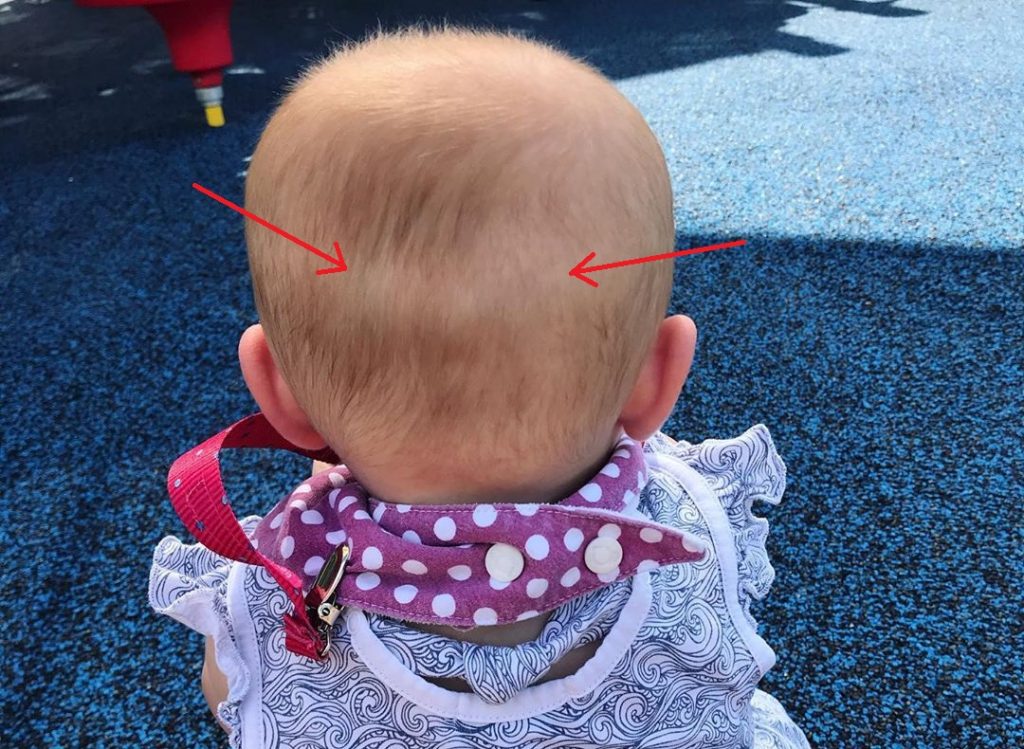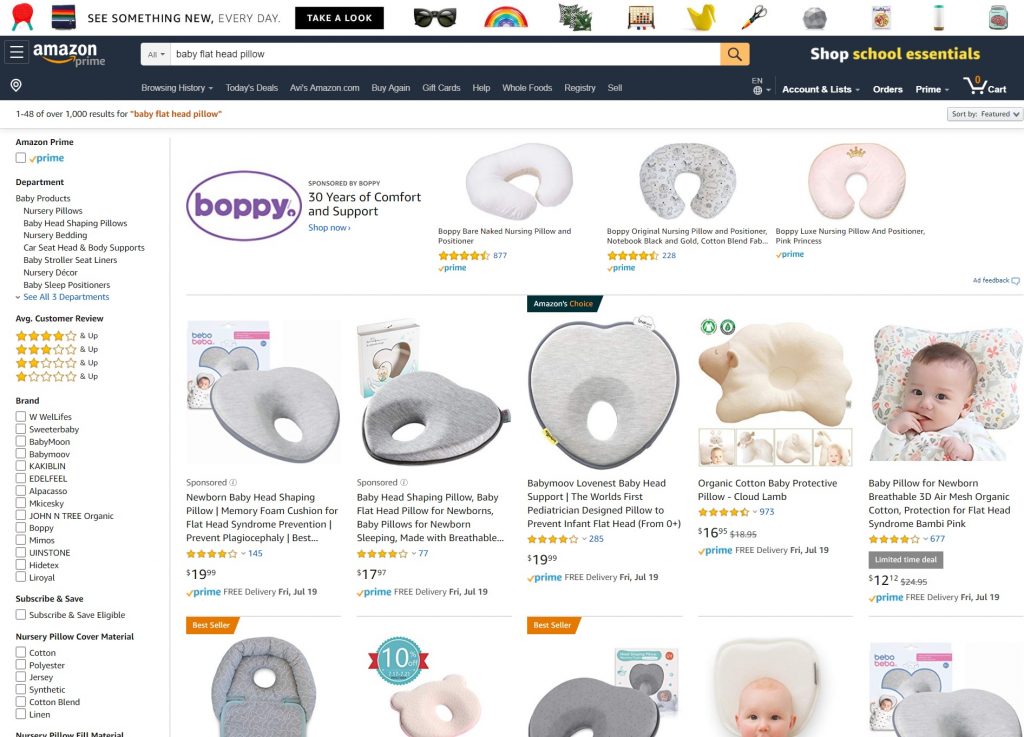When should I be concerned about a flat head?
/

This past weekend I was by my families annual Independence Day BBQ. The children were in the pool and the adults were enjoying each other’s company around the grill. I had my newborn on my lap and was sitting on a chair under the awning. After a while the kids began exiting the pool and getting online for a hot dog or hamburger from our favorite uncle Jimmy. From afar I was watching the kids and noticed something odd about my niece’s head shape, it just seemed a bit flat. Jane is an adorable seven-year-old girl with beautiful blond hair, but when I saw her come right out of the pool it appeared that the back of her head was flat. Being the nosey sister that I am, I asked my sister what was wrong with Jane’s head. She told me that when Jane was a baby, she noticed a flat spot on the back of her head. My sister took her to the doctor, and he said that it was called deformational plagiocephaly and would be fixed by itself. Turns out that it never got better and not until she grew a full head of hair were, they able to improvise that it should not be so noticeable. Only when Jane’s hair is wet will all the hairspray support make it sink into the flat spot on the head which is when I first noticed it.
After listening to my sister vent about how upset she was that her pediatrician never suggested cranial therapy I began running my fingers around the curvature of my little baby’s head. I felt the cute little bristles of his hair and then felt an ever so slight slope. It was situated right where the side of the head and back of the head meet. I never noticed it but I was unsure if I should be concerned about a flat head. As my sister was still going on and on, I thought I would ask her opinion about if she thought I should get it checked out. Just at that moment uncle Jimmy ask my sister to go get the steaks and ever since then I just never got the chance to ask her.

When should an infant’s head be checked for flatness?
After your baby is released from the hospital, he or she should be seen by a pediatrician. At that point the doctor will do a thorough check of the baby’s bones, limbs, reflexes, muscles, and overall strength. The doctor will then take out a tape measure and measure the circumference of the baby’s head. Medical professionals will not be as concerned if they find a deformity at this point since the infant skull bones are still coming together. However, as a parent and protector of your child you should ask if it’s normal. If you’re not satisfied with the pediatrician’s response, take them to a cranial specialist and get a thorough evaluation.
Keep a close eye on your baby’s head shape and make sure that his or her sleeping position does not make the flatness worse. The first few months are crucial because you may be able to avoid helmet therapy through manual therapy. Early intervention allows a therapist to build up the infant’s neck muscles so that the weight of the head should always be evenly distributed.
Therapy does not stop at your local cranial center. It continues throughout the day and around the clock. Sleep, which occupies 70% of a newborn’s day needs to be given a significant amount of attention. Of course, it’s recommended to put your baby back to sleep by the SIDS foundation, but at the same time you need to incorporate different techniques to get your baby to change head positioning. Baby head shaping pillows are available on Amazon in all different sizes which evenly distributes the weight of the baby’s head. But these pillows can sometimes be a nuisance to newborns depriving them of their much-needed sleep. That’s why you as the baby’s caregiver needs to engage them in exercises like tummy time and neck massages which might just be the best at home manual therapy.

How to identify flat head baby syndrome or positional plagiocephaly?
One of the first signs is the sight of a slight head deformity. This symptom may be hard to identify when looking at the baby eye to eye. You may start noticing the flat head when looking at the baby’s head from above. Try getting a good bird’s eye view of the spherical shape of your baby’s head. Sometimes it may be a bit easier to turn the baby on its side and take a good look at the back of the baby’s head. If the back of his or her head is flat, you will notice it right away.
Take, Jackson, a newborn baby boy whose mother noticed the back of his head seemed to be a bit flat. She made a note that the next time Jackson goes to the pediatrician she will ask what he think’s. Good thing that the following Monday the baby was scheduled to get some shots and the doctor would be able to look at the baby’s flat head. The doctor seemed to say it was normal and recommended to change the baby’s sleep position to the side as to alleviate the pressure on the back of the head. Keep in mind that newborns typically sleep 16 out or 24 hours in a day. That’s a huge amount of time being spent where the baby’s head is getting pressure to a specific area. Jackson’s mom tried switching his positions three times a night, but the baby kept reverting back to sleep. Flat head symptoms kept worsening and the baby’s skull kept on developing. Turns out that Jackson got to a local cranial center based on his mom doing some online research about plagiocephaly. He wore a baby helmet for approximately four months and the flat head deformity reverted to a normal head shape.

Why don’t pediatricians recommend a cranial specialist at first sight of a flat head?
Unfortunately, stories like Jackson’s are all too common. Doctors don’t view a head deformity like they would a baby suffering from a fever, bone break, or sickness. Think about it, the child can sleep, eat, and develop perfectly fine without addressing this head issue. In fact, it will probably be a big nuisance to place a baby in an orthopedic helmet to address the flat head. At the same time a large percentage of doctors still believe that flat head baby syndrome is a cosmetic condition and not medical.
A 2016 medical journal titled, Treated Versus Untreated Positional Head Deformity, concluded that there was a clear improvement when using an individual molding helmet for treating a nonsynostotic head deformity. Besides for the benefit of a normal head shape, the child won’t have to live with a head deformity. Just last week I could not take my eyes off how flat a guy’s head was. The older a person gets, the more noticeable it becomes. Imagine how easy it can be for a kid in elementary school to be bullied because of his odd shaped head. This can all be avoided by addressing your baby’s flat head sooner than later. As the skull begins to complete formation the harder it is to fix the flatness.
Physical therapist like Lisa Lewis, OTD, OTD/RL are spreading the importance and letting people know how easy it is to treat positional plagiocephaly: “Plagiocephaly or flat head baby syndrome is prevalent in about 47% of the infant baby population and we have seen a large increase in it since the back to sleep movement in the 90’s. While your baby is awake make sure to increase tummy time and try and avoid positions where the baby is on its back. Plagiocephaly happens due to the excess external pressure since our baby’s skulls are so soft”.

What about all these pillows on the market which are supposed to prevent the flat back of head?
The American Academy of Pediatrics recommends that there should be absolutely nothing in the crib. Following best practices like these has significantly reduced “crib death” (ie, SIDS) ever since they were implemented back in the 90’s. The number one form of treatment and prevention for positional plagiocephaly is re-positioning (not pillows). When tummy time and other exercises don’t have a positive impact on the baby’s head shape, that’s when you should go see an orthotist. Tummy time may be hard for your baby since they are not used to using these muscles. Weakness in the rope muscle in a baby’s neck is often what leads to conditions like torticollis and plagiocephaly. Tummy time does not always have to be when you’re on the floor getting a neck ache. It can be done while laying in bed with the baby on your chest. They will bob their head up and down which will get those muscles moving. As a mother and father, your job is to strengthen the baby’s neck muscles that they should not prefer to lean to one side of the head versus the other. Once your baby begins building up their strength, you will see less fussiness when doing a tummy exercise. It’s the same thing with grown adults. After the first workout your muscles ache tremendously but as you build up the strength they hurt less. Same thing with your little boy or girl, it’s a workout, it’s tiring, but it will get a beautiful head shape.

Cranial Therapy Centers is the only early interventions cranial center in the United States which provides both helmet and manual therapy treatment. We are American Board for Certification in Orthotics, Prosthetics and Pedorthics Facility. Visit us in Lakewood NJ, at 1352 River Ave Unit 14, Lakewood NJ, 08701 or in Teaneck NJ at 1086 Teaneck Road Suite 3F, Teaneck, NJ 07666. You can also email us info@cranialtherapycenters.com
